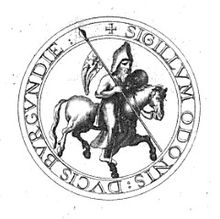Odo I, Duke of Burgundy

Odo I (1060 – 1102[1]), also known as Eudes, surnamed Borel and called the Red, was Duke of Burgundy between 1079 and 1103. Odo was the second son of Henry of Burgundy and grandson of Robert I. He became the duke following the abdication of his older brother, Hugh I, who retired to become a Benedictine monk.[2]
An interesting incident is reported of Odo by an eyewitness, Eadmer, biographer of Anselm of Canterbury. While Saint Anselm was progressing through Odo's territory on his way to Rome in 1097, the bandit, expecting great treasure in the archbishop's retinue, prepared to ambush and loot it. Coming upon the prelate's train, the duke asked for the archbishop, whom they had not found. Anselm promptly came forward and took the duke by surprise, saying "My lord duke, suffer me to embrace thee." The flabbergasted duke immediately allowed the bishop to embrace him and offered himself as Anselm's humble servant.
Odo was a participant in the ill-fated siege of Tudela in 1087[3] and in the Crusade of 1101.[4]
Family
Odo married Sibylla of Burgundy (1065–1101),[5] daughter of William I, Count of Burgundy, and became the father of:
- Helie of Burgundy 1080–1141, wife of Bertrand of Toulouse and William III of Ponthieu[1]
- Florine of Burgundy[1] 1083–1097, wife of Sweyn the Crusader, prince of Denmark
- Hugh II of Burgundy 1084–1143[1]
- Henry 1087–1125,[1] a priest
References
- ^ a b c d e Constance Brittain Bouchard, Sword, Miter, and Cloister: Nobility and the Church in Burgundy, 980–1198, (Cornell University Press, 1987), 256.
- ^ Constance Brittain Bouchard, Sword, Miter, and Cloister: Nobility and the Church in Burgundy, 980–1198, 129.
- ^ Spain in the Eleventh Century, Simon Barton, The New Cambridge Medieval History: Volume 4, C.1024-c.1198, Part II, ed. David Luscombe, Jonathan Riley-Smith, (Cambridge University Press, 2015), 187.
- ^ The Crusade of 1101, James Lea Cate,A History of the Crusades: The First Hundred Years, ed.Kenneth Meyer Setton and M. W. Baldwin, (The University of Wisconsin Press, 1969), 349.
- ^ Constance Brittain Bouchard, Sword, Miter, and Cloister: Nobility and the Church in Burgundy, 980–1198, 275.
- Gwatkin, H.M., Whitney, J.P. (ed) The Cambridge Medieval History: Volume II—The Rise of the Saracens and the Foundations of the Western Empire. Cambridge University Press, 1926.
